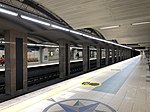Carmo Convent
1389 establishments in Europe14th-century establishments in Portugal15th-century Roman Catholic church buildingsAC with 0 elementsArchaeological museums in Portugal ... and 9 more
Christianity in LisbonConvents in PortugalGothic architecture in PortugalMuseums in LisbonNational monuments in Lisbon DistrictReligious buildings and structures completed in 1423Religious buildings and structures in LisbonRoman Catholic churches completed in 1423Ruins in Portugal

The Convent of Our Lady of Mount Carmel (Portuguese: Convento da Ordem do Carmo) is a former Catholic convent located in the civil parish of Santa Maria Maior, municipality of Lisbon, Portugal. The medieval convent was ruined during the sequence of the 1755 Lisbon earthquake, and the destroyed Gothic Church of Our Lady of Mount Carmel (Portuguese: Igreja do Carmo) on the southern facade of the convent is the main trace of the great earthquake still visible in the old city.
Excerpt from the Wikipedia article Carmo Convent (License: CC BY-SA 3.0, Authors, Images).Carmo Convent
Largo do Carmo, Lisbon Santa Maria Maior (Santa Maria Maior)
Geographical coordinates (GPS) Address Nearby Places Show on map
Geographical coordinates (GPS)
| Latitude | Longitude |
|---|---|
| N 38.712222222222 ° | E -9.14 ° |
Address
Igreja do Convento de Santa Maria do Carmo (Igreja do Convento do Carmo;Museu Arqueológico do Carmo;Ruínas do Carmo)
Largo do Carmo
1200-092 Lisbon, Santa Maria Maior (Santa Maria Maior)
Portugal
Open on Google Maps








